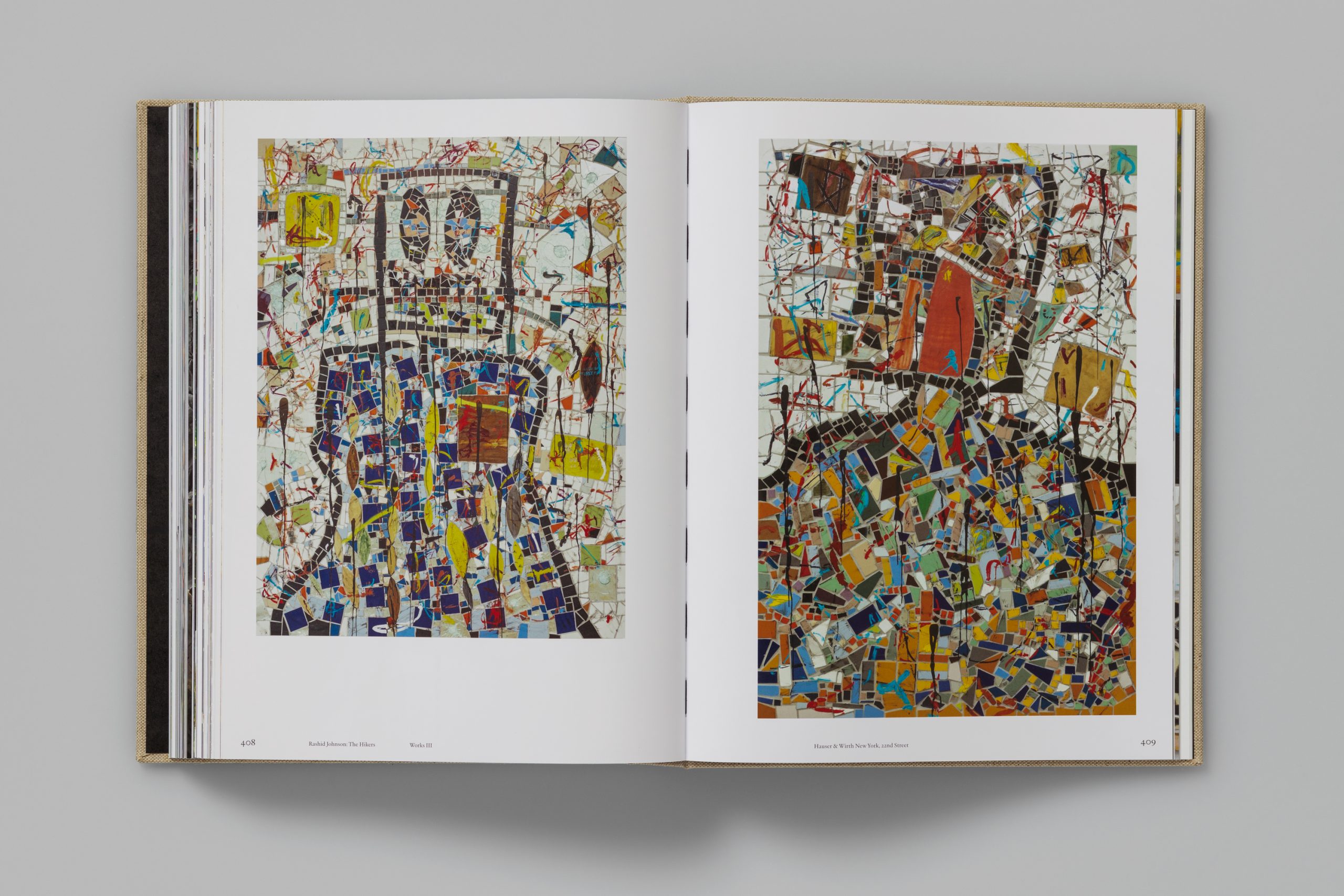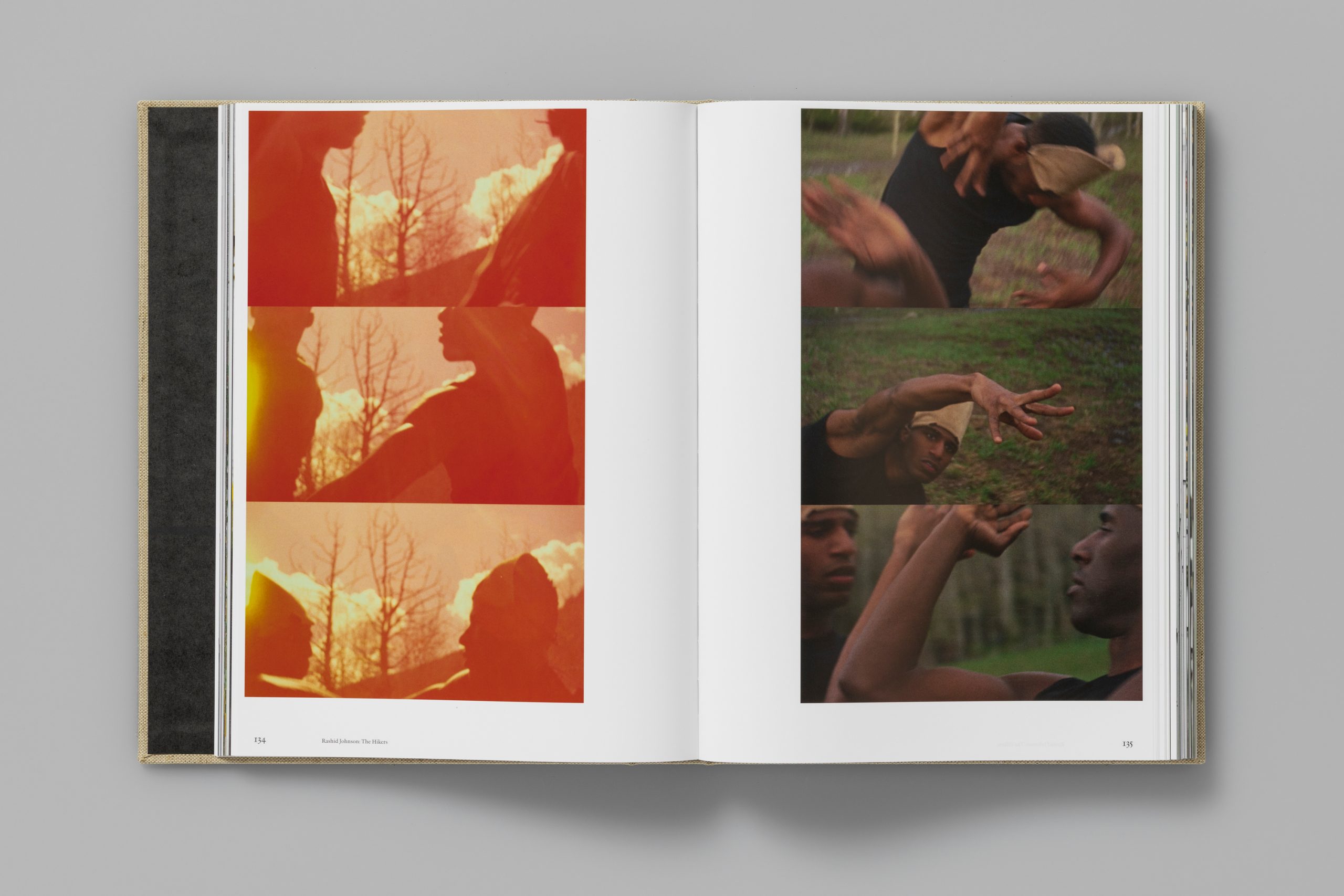 The front and back covers of Rashid Johnson’s The Hikers both bear a black print of Anxious Mask (2019), the canvas jacket of the book taking on a textural similarity to the scrawled oil-stick face upon animal skin. Depicted flat and unworn, the loose strings used to secure the mask resemble single hairs or dangling earrings. Only when worn are these strings tied behind the head and hidden, the animal skin wrapped and contorted to fit the wearer’s skull.
The front and back covers of Rashid Johnson’s The Hikers both bear a black print of Anxious Mask (2019), the canvas jacket of the book taking on a textural similarity to the scrawled oil-stick face upon animal skin. Depicted flat and unworn, the loose strings used to secure the mask resemble single hairs or dangling earrings. Only when worn are these strings tied behind the head and hidden, the animal skin wrapped and contorted to fit the wearer’s skull.
The anxiety and deception evoked by Johnson’s masks are key forces in The Hikers, the artist’s 2019 film from which a series of exhibitions and performances were developed. This book is the latest to emerge, documenting the various iterations of the work as it evolved at galleries and museums in Colorado, Mexico City and New York City. Published by Hauser & Wirth, the book includes installation imagery and a visual inventory of works. Also featured is a conversation between Johnson and Claudia Schreier, who choreographed ballet performances of The Hikers in which Rashid’s Anxious Masks were worn alongside simple black costuming.

The full range of Johnson’s mixed-media practice is on show here. Variously defined within abstract, conceptual and historicist traditions, the Chicago-born African American artist showcases collage, sculpture, mosaic, painting and film in The Hikers. Using materials including shea butter, cotton rag, soap, bronze, mirror and tile in large-scale installations, he sets out to capture the anxieties of existing in a world of turmoil as a Black American citizen. Works such as Untitled Escape Collage (2019) feel monumental, its geometric flashes revealing the mask imagery on its red oak surface, while Woodman (2014) and other smaller sculptures focus instead on how materials overlay and wear away at each other.
An essay in the book by Heidi Zuckerman begins by noting that anxiety featured heavily in her conversations with Johnson in 2018, doubtless in part a nod to the re-emergence of white nationalism in the US at the halfway point of the Trump presidency. Despite the three intervening years, this context feels renewed rather than retired in her essay: Johnson’s admittance to Zuckerman that “I’m concerned about the world my son is going to be inheriting” rings just as true today.
“Johnson’s appetite for formal experimentation is obvious, eager to bend and break dance orthodoxy in favour of more intuitive storytelling”
Zuckerman goes on to read several of Johnson’s works closely, favouring an intimate idiom rather than a distanced, more conventionally curatorial authority. She unpicks Untitled Anxious Audience (2016), a large ceramic tile work bearing 34 pseudo-robotic faces, and Untitled Microphone Sculpture (2018), whose single face, Zuckerman writes, parallels “the way we pace around the kitchen on a conference call… simultaneously hyperproductive and present, and distracted and self-doubting.”
Curator Manuela Moscoso’s essay focuses on touch and materiality. Johnson’s works, she argues, “do invoke a non-ocular-centric mode of interpretation… his materials, such as shea butter or black soap, stimulate tactile memories; both their composition and their finish encourage haptic viewing.” She casts the skin as a mediating force through which we distinguish forms of touch, arguing that The Hikers film, “triggers this sense of touch as a figure of relation” via its depiction of two Black walkers and their interactions with the land, while also tapping into long-standing literary depictions of the wanderer and the revelatory potential of natural exploration.

The photographic spreads of the ballet (supplemented by Johnson’s conversation with Schreier) distinguish the book from straightforward inventory. The performance explores the ways in which people minimise, contort and express themselves in an embodied fashion, whether to communicate a feeling or element of their personalities, or to disguise or shield themselves from an external agent. “This idea of being Black and feeling outside of oneself” was the choreography’s central idea, Schreier says. Johnson’s appetite for formal experimentation is obvious, eager to bend and break dance orthodoxy in favour of more intuitive storytelling.
Schreier says that it was upon seeing the masks—how “deeply disturbing” they were—that she realised the pair in The Hikers ballet could not reasonably come to a romantic conclusion. Out of this judgement came a different direction, a new route prompted by a visceral reaction to Johnson’s work. Across three American cities and some 450 pages, this power to move freely beyond convention is thankfully retained.






